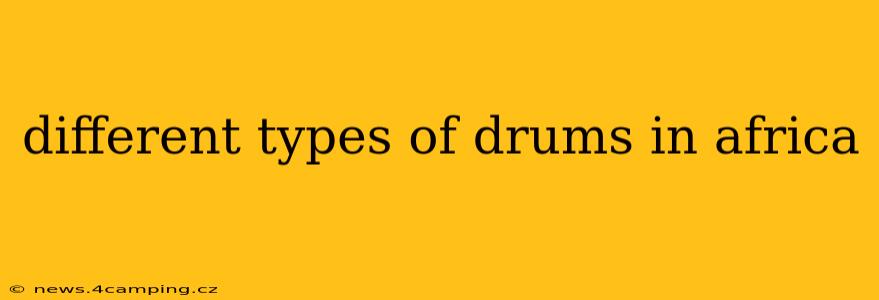Africa's diverse musical landscape is profoundly shaped by its rich variety of drums. These instruments are not merely percussion; they are integral to storytelling, ceremonies, celebrations, and everyday life across the continent's many cultures. Understanding the different types of African drums requires acknowledging the vast geographical and cultural differences across the continent. This exploration won't be exhaustive—the sheer number of drum types is staggering—but it will provide a valuable introduction to some of the most prominent and influential.
What are the main types of African drums?
This question is best answered by categorizing drums based on their construction and playing techniques, rather than trying to list every single type. Many drums share similarities across regions, even though they may have unique names and slight variations in construction.
1. Membranophones (Drums with Skins): This is the most common category. African drums are predominantly membranophones, utilizing animal skins stretched over a resonating body. These can be further categorized by several factors:
- Shape and Size: Drums come in various shapes—cylindrical, conical, hourglass, goblet—and sizes, impacting the pitch and tone produced. Smaller drums often have higher pitches, while larger drums produce deeper, resonant sounds.
- Material: The resonating body (shell) can be made from wood, clay, metal, or even gourds. This significantly impacts the drum's resonance and overall sound.
- Tuning: Some drums are tunable, allowing for adjustments to pitch. Others are fixed-pitch instruments.
- Playing Technique: Drums are played with hands, sticks, mallets, or a combination thereof. The playing technique profoundly influences the sound.
2. Idiophones (Drums that are also the Sound Source): While less common than membranophones in African drumming, idiophones exist. These are instruments where the body of the instrument itself vibrates to produce sound. Examples include various types of slit drums, which are hollowed-out logs with slits carved into them.
What are some examples of specific African drums?
Let's look at a few specific examples from different regions to illustrate the diversity:
-
Djembe (West Africa): Perhaps the most internationally recognized African drum, the djembe is a goblet-shaped drum played with bare hands. Its warm, resonant sound makes it popular in various musical genres worldwide.
-
Talking Drum (West Africa): These drums, particularly prevalent among the Yoruba people of Nigeria, are known for their ability to mimic the human voice. Their unique hourglass shape and taut skin allow skilled players to manipulate the pitch and create intricate rhythmic patterns.
-
Conga (Cuba): While often associated with Cuban music, the conga's origins are rooted in the traditional drums of Congo, Central Africa. Its barrel shape and deep tone are unmistakable.
-
Udu (Nigeria): This clay pot drum offers a unique sound quality, with its resonating body acting as a sound chamber. It's known for its ability to produce a range of sounds, from deep, resonant tones to high-pitched clicks.
-
Ingoma (Rwanda/Burundi): These large, cylindrical drums are integral to Rwandan and Burundian culture. They are often played in large ensembles, creating powerful, rhythmic soundscapes.
How many different kinds of drums are there in Africa?
There's no single definitive answer to this question. The sheer number of different types of drums across Africa, factoring in regional variations and unique constructions, is incredibly high. Thousands of variations exist, shaped by specific cultural traditions and the availability of materials.
What is the most common type of drum in Africa?
There's no single "most common" type, given the incredible variety across the continent. However, membranophones, especially those made from wood and animal skins, are undoubtedly prevalent across many regions.
What are some famous African drummers?
Numerous incredibly talented drummers have emerged from Africa, shaping its musical landscape. Sadly, many are not as widely recognized internationally as Western musicians. Research into specific regional traditions will reveal many master drummers who've passed down their skills through generations.
This exploration provides a glimpse into the rich world of African drums. It is a testament to the continent's vibrant cultural heritage and the enduring power of rhythm and music. Further research into specific regions and cultures will uncover even more fascinating instruments and traditions.
